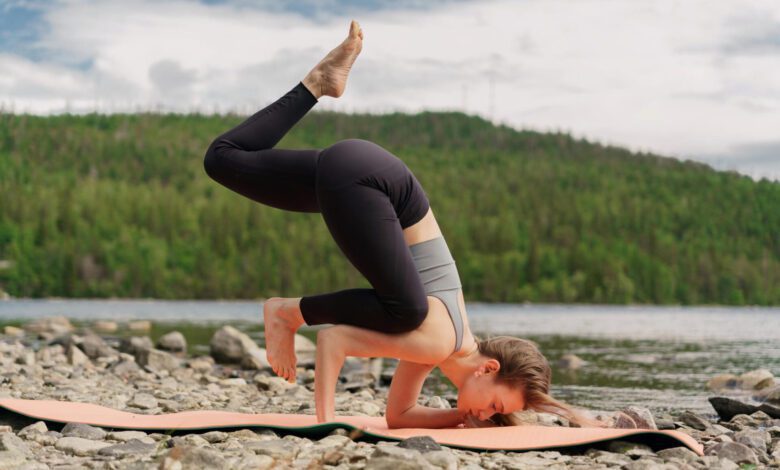Yoga Poses Hard: Advanced Techniques from Scorpion to Dragonfly

1. Introduction to Advanced Yoga Poses
The world of yoga is as vast as the universe itself, with an endless variety of poses and practices. From the simple child’s pose to the intricate and demanding Scorpion Pose, there’s a stretch, balance, or meditative posture for everyone. But when we delve into the realm of advanced yoga poses, we step into a category that demands both physical prowess and mental determination. These poses aren’t just for the body; they’re for the spirit and the mind, challenging us in ways we never thought possible.
1.1. The Evolution from Beginner to Advanced Practice
Every yogi starts somewhere. Often, it’s with a basic understanding of yoga postures and a desire to seek physical flexibility or mental calmness. But as time progresses, the quest often evolves. The journey from basic yoga poses to hard yoga poses is marked by perseverance, dedication, and an innate desire to push one’s boundaries. It’s like transitioning from a gentle stream to raging rapids, where the challenge is tougher, but the thrill is incomparable.
1.2. Understanding the Need for Mastering Hard Yoga Poses
But why would anyone want to twist themselves into pretzel-like shapes or balance on one hand? The answer lies in the pursuit of mastery. Advanced yoga techniques offer a deeper connection to one’s body and mind. They challenge our limits and teach us resilience. Moreover, achieving poses like the Scorpion Pose or Dragonfly Pose isn’t just about physical flexibility; it’s about mental tenacity, focus, and the power of the human spirit.
1.3. Yoga Poses Hard: Challenging yet Rewarding
There’s a common saying in the yoga community: “It’s not about being good at something. It’s about being good to yourself.” Even in the world of advanced yoga, this holds true. While these hard yoga poses may seem daunting at first, the journey to achieve them is filled with valuable lessons. Each attempt, even if unsuccessful, teaches patience, humility, and determination. And once achieved, the sense of accomplishment is unparalleled.
1.4. The Role of Commitment in Advanced Yoga Techniques
Commitment is the bridge between wanting and achieving. It’s the secret ingredient that transforms dreams into reality. In the world of advanced yoga practice, this commitment translates to consistent practice, continual learning, and an unwavering belief in oneself. It’s about showing up on the mat every day, even when the poses seem impossible. After all, every expert was once a beginner, and every yogi has faced their own set of challenges before achieving mastery in yoga.
2. The Beauty and Challenge of Scorpion Pose
2.1. Scorpion Pose Overview: Engaging the Core and Upper Body
The Scorpion Pose is one of the most visually stunning and challenging yoga positions that truly demonstrates a yogi’s mastery in the practice. It’s not merely about flexibility; this pose is a testament to arm strength, balance, and control. At its core (pun intended), the Scorpion Pose is all about engaging your core and upper body muscles.
Imagine holding your entire body weight in a delicate balance on your hands. Sounds tough, right? That’s because it is. But the beauty of this pose isn’t just in its physical challenge. It’s in the inner strength, focus, and determination required to achieve it. With the right approach, the Scorpion Pose can be a crown jewel in any advanced yoga practice.
2.2. Mastery in Scorpion: Tips and Techniques
As with most advanced yoga poses, the journey to mastering the Scorpion Pose involves a mix of physical preparation and mental focus. Here are some essential tips to help you along:
- Engage Your Core: This can’t be emphasized enough. A strong core is the foundation of this pose. Regularly practicing planks, boat pose, and other standing core yoga poses will be beneficial.
- Build Arm Strength: Since your arms act as the pillars holding up the pose, strengthening exercises like push-ups, tricep dips, and specific arm balancing yoga poses will help.
- Practice with a Wall: Starting against a wall provides a safety net, allowing you to get a feel of the pose without the fear of toppling over.
Remember, patience and consistent practice are crucial. There’s no rushing mastery, especially in advanced yoga.
2.3. Common Mistakes and How to Correct Them in the Scorpion Pose
Every yogi, from novice to expert, can fall prey to common mistakes. In the Scorpion Pose, awareness is crucial. Here are some frequent pitfalls:
- Not Warming Up Properly: Before diving into the Scorpion, ensure you’re adequately warmed up, particularly your spine, shoulders, and hips.
- Placing Hands Too Wide: Your hands should be shoulder-width apart to provide optimum balance and support.
- Forgetting to Breathe: It’s easy to hold your breath when concentrating, but deep, steady breathing will help stabilize the pose and calm your mind.
Being aware of these mistakes is half the battle. With mindfulness and advanced yoga techniques, you’ll find yourself making fewer errors over time.
2.4. How to Perfect the Scorpion Pose in Yoga
Perfection in yoga is a journey, not a destination. But for those keen on refining their Scorpion Pose, here are some pointers:
- Engage in Deep Breathing: Remember to engage your core and breathe deeply. It helps in balancing and provides the necessary stamina.
- Align Your Hips: Ensure your hips are above your shoulders. This alignment is essential for balance and to reduce undue strain.
- Stay Relaxed: While it’s a strenuous pose, try to keep your face and neck relaxed. It aids in maintaining a steady position.
- Use Props: Props can provide support and allow you to understand the depth and alignment of the pose better.
With time, dedication, and the right techniques, the Scorpion Pose can move from being a challenge to a cherished part of your yoga routine.
3. Unraveling the Mystique of Dragonfly Pose
3.1. Introduction to Dragonfly Pose – A symbol of balance and strength.
The Dragonfly Pose stands as a testament to the marvels of advanced yoga poses, offering practitioners a unique blend of strength, balance, and grace. Often regarded as a symbol of transformation and adaptability, the Dragonfly Pose mirrors the elegance and resilience of its namesake insect. As one delves into the world of hard yoga poses, there’s an undeniable allure that the Dragonfly Pose presents, beckoning the dedicated and the tenacious.
Like any art form, the foundation of this pose lies in understanding its essence and anatomy. The Dragonfly Pose isn’t just a display of physical prowess but is a manifestation of mental strength and focus. It challenges not just your limbs, but the very core of your being. As you embark on this journey, you’re not merely adopting a posture, but embracing an ethos of persistence, patience, and unwavering dedication.
3.2. Techniques for mastering Dragonfly Pose.
For those wondering how to dragonfly, it’s essential to acknowledge the significance of technique. Proper technique not only ensures that the pose is executed correctly, but it also minimizes the risk of injury. To begin, start by sitting in a comfortable position, extending one leg outwards while the other foot rests on the opposite thigh. Now, position your hands on either side of the outstretched leg, preparing to lift your body.
- Engage your core: This will provide the necessary stability.
- Arm strength: Essential for lifting and holding the pose.
- Hip opening: Facilitates the twisting required for the posture.
Transitioning into the Dragonfly Pose requires a delicate balance between arm strength and core engagement. With practice, you’ll find a seamless harmony, making the pose feel almost effortless.
3.3. Engage your core: The secret to achieving the Dragonfly Pose.
The core, often the unsung hero in advanced yoga, plays a pivotal role in the Dragonfly Pose. An engaged core acts as the anchor, providing stability and balance. Imagine your core as the roots of a tree, delving deep into the ground, offering unwavering support to the trunk and branches.
Engaging your core is more than just tensing your stomach muscles; it’s about harnessing the collective strength of the abdomen, obliques, and lower back. This synergy allows for controlled, fluid movements, making poses like the Dragonfly achievable and sustainable. Remember, in the realm of yoga poses hard in technique, a robust core is your best ally.
3.4. Challenges and benefits of the Scorpion and Dragonfly poses.
Both the Dragonfly and Scorpion Pose offer a unique set of challenges and rewards, making them a sought-after milestone in an individual’s advanced yoga journey.
Challenges:
- Arm balancing yoga poses: Both poses require substantial arm strength.
- Engage your core: Essential for stability and balance in these poses.
- Flexibility: Especially in the hips and spine, is crucial.
Benefits:
- Upper body strength: These poses act as a natural weight-bearing exercise for the arms and shoulders.
- Enhanced balance and coordination: Regular practice can significantly improve proprioception.
- Mental fortitude: Mastering these advanced yoga poses fosters resilience, patience, and determination.
In the vast universe of yoga poses, the Dragonfly and Scorpion stand out, not just for their complexity but for the holistic growth they offer. They are more than just postures; they are a journey, a testament to human spirit and perseverance.
4. Enhancing Your Advanced Yoga Flow
Yoga isn’t just about nailing a pose; it’s about the flow, the transition, and the synchronization of breath with movement. Let’s delve into how to enhance your advanced yoga flow and seamlessly move between those intricate poses.
4.1. Advanced yoga demo – Transitioning between poses
Transitioning between hard yoga poses can be as challenging, if not more, than holding the pose itself. But with proper technique and understanding, this can become a dance of beauty.
- First, it’s essential to engage your core; this isn’t just your abs but also the deeper muscles that provide stability. Think of it as the bridge that connects your upper and lower body.
- Shifting your weight appropriately and understanding the pivot points in transitions are crucial. For instance, when moving from a standing pose to an arm balancing yoga pose, your weight shifts from the legs to the arms and core.
4.2. Asanas for Experts: Exploring other hard yoga poses
Apart from the Scorpion and Dragonfly, there are numerous challenging yoga poses that experts often seek. Some of these include advanced twisting yoga poses and standing core yoga poses. Each pose brings its own set of challenges and benefits.
- Advanced hip opening poses help in releasing stored emotions and improving flexibility. These can be beneficial, especially for those who sit for prolonged periods.
- Arm balancing poses not only strengthen the upper body but also improve focus and concentration.
4.3. Tips for transitioning between advanced yoga poses
Making smooth transitions in advanced yoga practice requires a blend of strength, balance, and awareness. Here are some pointers:
- Use your breath as a guide. A smooth and deep breath can aid in smoother transitions. For example, inhale when you’re extending or stretching and exhale when folding or contracting.
- Always keep your eyes fixed on a particular point, also known as ‘Drishti’ in yoga. This helps in maintaining balance, especially during tricky transitions.
4.4. Arm strength and balance: The key to advanced arm balancing yoga poses
Arm strength is the cornerstone of many advanced yoga poses. But it’s not just about having strong arms; it’s about how you engage them.
- Start with basic weight-bearing exercises to build strength. This could be simple plank holds or downward-facing dog. Remember, it’s not about how long you hold but how well.
- Balance plays a pivotal role too. Engage your core muscles and distribute your weight evenly. Whether it’s the Scorpion Pose or any other arm balance, remember to press down through your palms and fingers to lift your body.
Remember, yoga is a journey. Some days, certain poses will feel more natural, and on others, even the simplest might seem challenging. What’s essential is the consistency of practice and the intent behind it. Over time, with dedication, you’ll find yourself transitioning seamlessly through the most advanced yoga poses.
Embracing advanced yoga techniques doesn’t mean pushing your body beyond its limits. It’s about understanding those limits and expanding them through consistent practice, proper technique, and unwavering dedication. So, are you ready to take your practice to the next level and dive deeper into these hard yoga poses?
5. Conclusion: The Journey of Mastery in Advanced Yoga Techniques
The culmination of mastering advanced yoga practices brings a unique sense of accomplishment and enlightenment. This journey of advanced yoga pushes practitioners beyond their physical and mental limits, revealing their inner strength and potential.
5.1. Reflecting on the rewards of advanced yoga practice
- The practice of Yoga Poses Hard and other advanced asanas offers a deep connection between the mind, body, and spirit. This connection not only enhances our physical capabilities but also nurtures our mental and emotional well-being. By mastering challenging poses like the Scorpion Pose and Dragonfly Pose, practitioners often experience a surge in self-confidence and a deeper understanding of their body’s capabilities. These postures not only represent a physical achievement but also symbolize the overcoming of one’s mental barriers.
- Furthermore, there’s an undeniable sense of satisfaction in conquering hard yoga poses. This accomplishment is a testament to dedication, perseverance, and patience. Beyond the physical rewards, such as increased flexibility or arm strength, there’s a transformative journey of self-discovery. It’s about understanding one’s boundaries and then pushing past them.
5.2. The importance of continued practice and persistence
- In the world of yoga, the journey never truly ends. As one pose is mastered, another emerges, bringing with it new challenges and opportunities for growth. This cyclical nature of yoga emphasizes the importance of persistence and continuous practice. The beauty lies in the process, not just the outcome. Each session, no matter how challenging, contributes to overall progress.
- Commitment is key. While it might be tempting to rest on the laurels after mastering a particular pose, true yogis understand that yoga is a lifelong practice. With advanced yoga techniques constantly evolving and introducing new challenges, the learning never stops. The discipline cultivated during the initial stages of learning hard poses stays with practitioners, urging them to keep pushing forward.
5.3. Safely practicing challenging asanas in yoga
- Safety should always be a priority when diving into advanced yoga postures. Ensuring proper alignment, warming up adequately, and listening to one’s body are crucial. It’s essential to recognize the difference between pushing oneself and risking injury. Poses like the Scorpion and Dragonfly demand not only physical strength but also a strong sense of body awareness.
- It’s equally important to remember that every individual’s journey is unique. Comparing oneself to others can be detrimental and discouraging. Instead, embracing one’s path, celebrating small victories, and understanding that setbacks are a part of growth can make the journey more fulfilling. Seeking guidance from experienced teachers and attending advanced yoga demos can provide invaluable insights and ensure safe practice.
5.4. The future of advanced yoga: Where to go next?
- The world of advanced yoga is vast and ever-evolving. As practitioners master current poses, there’s always something new on the horizon. Exploring different styles, attending workshops, or diving into advanced yoga flows can add new dimensions to one’s practice.
- Embracing the spirit of continuous learning can lead to a deeper understanding of yoga techniques and a richer practice experience. From experimenting with arm balancing yoga poses to exploring advanced hip-opening sequences, the possibilities are endless. And as the yoga community continues to grow and innovate, there will always be new techniques, poses, and philosophies to explore.
In conclusion, the world of advanced yoga is not just about physical prowess. It’s a beautiful blend of mental perseverance, spiritual growth, and continuous learning. By understanding the importance of persistence, prioritizing safety, and staying curious about new techniques, practitioners can enjoy a rewarding and ever-evolving yoga journey.
6. FAQ: Yoga Poses Hard: Advanced Techniques from Scorpion to Dragonfly
Q1. Why are the Scorpion and Dragonfly considered advanced yoga poses?
A: The Scorpion Pose and Dragonfly Pose are considered among the advanced yoga poses primarily due to the balance, flexibility, and strength they demand. The Scorpion Pose, or Vrschikasana, requires significant upper body strength, a strong core, and immense spine flexibility. It’s essentially a backbend and an inversion combined. On the other hand, the Dragonfly Pose, also known as Maksikanagasana, is an advanced arm balance that incorporates deep hip opening and demands both flexibility and arm strength. Engaging these techniques safely and correctly means having mastered foundational postures first.
These poses are also a testament to the advanced yoga techniques that require not just physical readiness but also mental preparation. Mastery in such poses signifies both dedication to the practice and a deeper understanding of one’s body.
Q2. How long does it typically take to master these advanced yoga poses?
A: The journey to mastering hard yoga poses like the Scorpion and Dragonfly varies for every individual. Some might find themselves easing into these postures after a year of dedicated practice, while others might need several years. Factors that affect the timeline include one’s baseline flexibility, strength, frequency of practice, and the quality of guidance they receive.
It’s essential to remember that yoga is a personal journey. Instead of focusing on how long it takes, the emphasis should be on the process, understanding your body, and ensuring safe progression.
Q3. Are there any specific preparatory poses or exercises to aid in achieving the Scorpion and Dragonfly poses?
A: Absolutely! Before diving into these advanced yoga poses, there are several preparatory poses and exercises that can be immensely helpful. For the Scorpion Pose, focusing on building upper body strength through poses like Downward Dog, Forearm Plank, and Dolphin can be beneficial. Additionally, practicing backbends like the Cobra and Bow poses can enhance spine flexibility.
For the Dragonfly Pose, poses that promote hip opening such as the Pigeon Pose, Firelog Pose, and Butterfly Pose are great starters. Also, arm balances like Crow Pose can provide a solid foundation in terms of arm strength and balance.
Q4. Are there any risks associated with practicing these advanced yoga techniques?
A: As with any advanced yoga practice, there are inherent risks if poses are approached without proper preparation or awareness. The Scorpion Pose, being an inversion, can put undue strain on the neck if not done correctly. Similarly, without proper hip opening, diving straight into the Dragonfly Pose can strain the hips and lower back.
It’s crucial to always listen to your body, progress at your own pace, and ideally, practice under the guidance of an experienced yoga instructor. It’s also beneficial to integrate the principle of “Safely practicing challenging asanas in yoga” to prevent injuries.
Q5. Can beginners attempt these poses, or should they wait until they’re more experienced?
A: While enthusiasm is admirable, hard yoga poses like the Scorpion and Dragonfly are labeled “advanced” for a reason. Beginners should focus on building a strong foundation with basic postures, enhancing their flexibility, strength, and balance before attempting these advanced techniques.
Jumping into such poses prematurely can lead to injuries and discouragement. However, beginners can start with the preparatory poses mentioned earlier and gradually work their way up, relishing each step of their advanced yoga journey.





